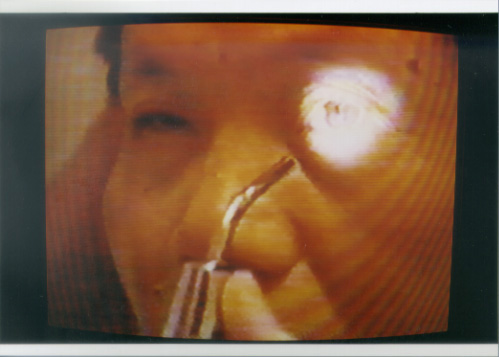
| Order | Index/Search | Home | About Us | Whats New |

|
|

|
Tran T. Kim-Trang and Karl Mihail's public art installation Gene Genies Worldwide (1998) created a seductive retail space for a fictitious company offering to custom design clients' genetic codes. Behind an immaculate red brick facade, Plexiglas display cases presented the various bio-related components of the installation with formality and great attention to aesthetics. One pristine display case contained a row of literary classics updated by the artists ("Eugenic America"; "Genetic Scarlet Letter"); a single text lay open to reveal grinning images of artists/providers peering into microscopes. Another display labeled "One Step Closer to God", a radiant light-box displayed eight dazzling close-ups of genetic elements that glistened like mineral samples. Another display held an offering of petri dishes arranged like purses in a boutique. Elsewhere, human and animal skulls were grouped against a satin backdrop --- and a mini DNA strand, a model of molecules, and a row of pristine test tubes completed the depiction of science as art and retail. The presentation, presided over by life-size images of the two scientist/artists, was an ironic evocation of a viable future scenario that raises provocative ethical, economic, and social issues. More recently, the artists produced The Creative Gene Harvest Archive (1999), a display of hair samples from creative individuals, which was similarly presented in an austere laboratory-like display. Donors included James Watson, the biochemist who codiscovered the DNA double helix; Ian Wilmut, the embryologist who cloned "Dolly" the Sheep; Stanley R. Prusiner, the neurologist who discovered prions; Mary-Claire King, the U.C. Berkeley professor who located the breast cancer gene; Damian Hurst, the vanguard British artist; I.M. Pei, the architect; and Jeremy Rifkin, the author of "The Biotech Revolution." The professed goal of these and all similar projects was "to be an incubator for cultural and scientific experiments, bringing in a new age of value production and commodity exchange." --Barbara Lee Williams, Leonardo/ISAST Awards Committee chairperson __________________________________________________ (artist questionnaire) Date of birth: 1966 (Kim-Trang) Date and location of your first major exhibition: Siggraph and the European Media Art Festival, 1993 Location where you currently work (city and country): Los Angeles, California, U.S.A. How do you see technology changing art for the good or ill in the next decade?: [Kim-Trang answers:] I am ambivalent about technology's role in the arts for the next decade. While it's exciting to see artists working with so many different technologies, especially in old and new media and biotechnology --- changing the tools and being changed by them ---I am wary of how quickly and uncritically they are being applied. I look forward to the next decade, when we may have truly matured with the various current technologies, as they come to pervade our lives and our arts. |